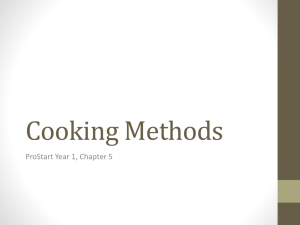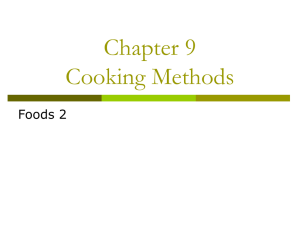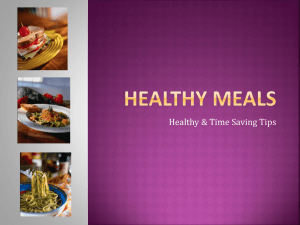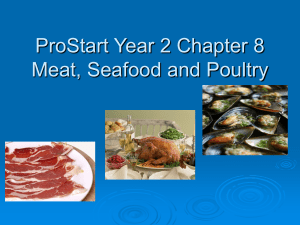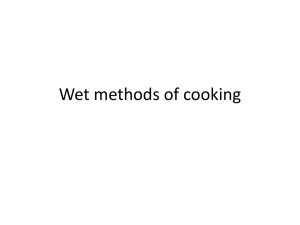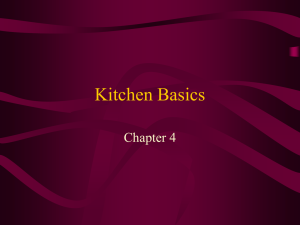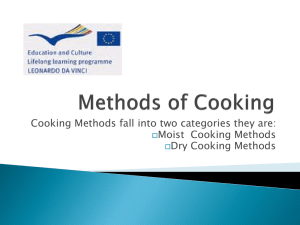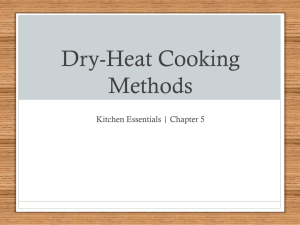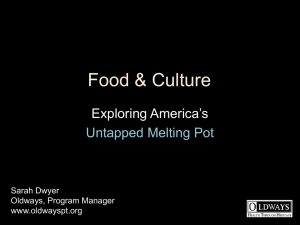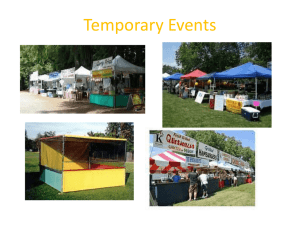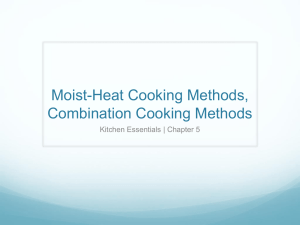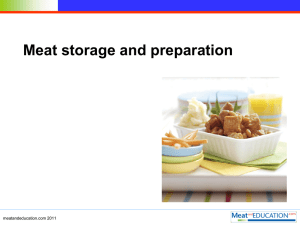Methods of Cooking - Bohunt School VLE
advertisement
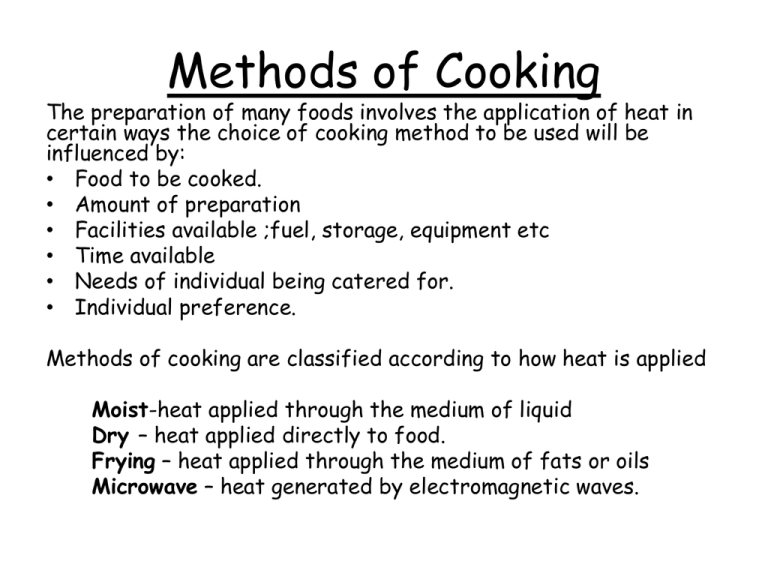
Methods of Cooking The preparation of many foods involves the application of heat in certain ways the choice of cooking method to be used will be influenced by: • Food to be cooked. • Amount of preparation • Facilities available ;fuel, storage, equipment etc • Time available • Needs of individual being catered for. • Individual preference. Methods of cooking are classified according to how heat is applied Moist-heat applied through the medium of liquid Dry – heat applied directly to food. Frying – heat applied through the medium of fats or oils Microwave – heat generated by electromagnetic waves. Moist Methods Relatively low temperatures are used which may prolong the cooking time of some foods. The liquid medium may be water, steam, stock milk ,fruit juice wine or beer. Moist methods Include: • Boiling / Simmering • Poaching • Steaming • Pressure cooker • Slow Cookers • Stewing • Braising Boiling Food is cooked in boiling water to tenderise them, the water reaches 100 c which causes rapid movement of the water molecules due to heat transfer by convection currents. It is best to boil vegetables in a small amount of water for as little time as possible to conserve their vitamins Adv • Water is readily available • Food is unlikely to burn though it may disintegrate if overcooked. Dis – • Nutrients may be lost • Some flavour is lost from meat Suitable Foods Muscular cuts of meat: • Lamb- middle neck • Beef –brisket, silverside • Pork – Knuckle, ham • Most Veg • Eggs • Pasta, Rice cereal • Fish Poaching / Simmering Very gentle methods of cooking Poached food is cooked in a shallow pan of simmering liquid, which can be flavoured. It is a good way of cooking: Suitable Foods : • Eggs • Fish • Some fruits, such as pears and peaches Steaming Steamed food is cooked over boiling water, either on a hob or in an electric steamer. A gentler method of cooking The steam rises and cooks the food without it being actually in the water.(convection). The food keeps more of its water soluble vitamins. Steamers are economical with fuel because several foods can be cooked at once in layers Pressure cooker Adv – • Economical on fuel • Meals can be prepared quickly • Nutrient loss is reduced though heat destruction still occurs. • Whole meals can be cooked in one pan • Tough cuts of meat can be cooked quickly. Dis – Adv – Loss of nutrients is reduced as the • Careful timing is important to food does not come in direct prevent foods such as veg from contact with the water. being overcooked. Makes the food easy to digest as it has a lighter texture. • Little attention is required while the food is cooking except replenish the water. • Food is unlikely to be overcooked. Dis – • Food takes a long time to cook Suitable Foods • Potatoes & other Veg, Fish, pudding • Suitable foods • Soups & stocks. • Stews & casseroles • Jam making & fruit boiling • Vegetables • Puddings Slow Cookers : Stewing cooking can make cheap tough Slow method of cooking on the hob or in the oven for a period of cuts of meat really tender. They several hours. The heat is can be plugged in and left all day. transferred to the food through Adva mixture of conduction and • The pot can be left unattended convention little fuel is used Adv • Tough cuts of meat can be • Tenderiser tough cuts of meat tenderised • Nutrients lost are kept to a Dis – minimum as the liquid is served • Meat & poultry may have to be with the meal browned beforehand. • Pulses & beans may not cook properly • Improves certain fruits as the cellulose is softened eg rhubarb Braising • Large variety of stews & Similar to stewing but uses less liquid, casseroles can be prepared cooked for several hours at a low • A whole meal can be prepared in temperature one container. Adv – Dis – • A whole meal cooked in one pot • Long slow method of cooking • Tough cuts of meat can be used Dis – May need to be grilled at the end • Little variation in texture to give colour Suitable Foods Suitable Foods • Beef, Lamb,Poultry • Beef, Rabbit, lamb, Poultry, offal • Fruit Dry Method Higher temperatures are used in dry cooking Roasting involves cooking foods in a hot oven with a little fat turning occasionally to give a crispy surface. Heat is transferred by conduction which causes the water to evaporate from the food which concentrates the flavours in the food You can roast: • meat and poultry • potatoes and other root vegetables Adv – • Tenderises suitable joints • Little attention is required except to baste the joint Dis • A lot of moisture is lost by evaporation • Meat may shrink • High temp may result in toughening of protein Baking Baked foods are cooked in a hot oven without adding any extra fat. The heat causes the food to rise and then set. It is important to ensure the oven is hot , so that the process of rising starts straight away. It is important not to open the oven door during baking as the cold, heavy air that will get drawn in causes the baked food item to sink. In gas ovens the hottest part is the top as the hot air rises to the top by convection. Many electric ovens are fan assisted which means that a fan blows the hot air around so that the temperature is the same on all shelves, they also can cook the food quicker so the cooking time may have to be reduced You can bake: Bread, pastry and cakes, • Fish .potatoes. Grilling • Is the cooking of food by Radiation. The surface of the food is quickly sealed and the flavour is well developed. • The food must be moistened with fat to prevent drying out and turned frequently to ensure even cooking. • Food is placed on a very hot grill until it browns, then the heat is turned down until the food is cooked through. • The food should not be more than 2.5- 3.5 cm thick to allow heat penetration • Grilled food can be cooked indoors on a grill or outdoors on a barbeque It is a good way of cooking tender meat and poultry, fish and vegetables • Grilling is healthier than frying as it uses less fat. Barbecuing Is a method of cooking where foods are cooked on a metal grill over hot , glowing charcoal, or on a modern gas barbecue The food is cooked by radiation, from the hot coals and if charcoal is used it gives the food a smoky flavour. The food needs to be turned frequently to ensure even cooking. The temperature of the coals must be controlled so that the food cooks right the way through and not just on the outside. If not cooked properly the food may cause food poisoning. Suitable foods are small meat and poultry joints, sausages, burgers, kebabs, fish . Sweet corn , mushrooms tomatoes & potatoes Frying • A Quick, convenient method of cooking which involves high temperatures. • The fat or oil used for deep fat frying must be suitable for heating up to 200oC without burning. • Reduced fat spreads have a high water content and are not suitable for frying as the water causes the fat to spit when heated and so is dangerous. There are four types of frying • Deep • Shallow • Dry • Stir Deep frying Involves the immersion of food in a pan of hot fat. Deep fried foods are high in Fat but • Do not allow oil to become too Hot or it will smoke and rapidly catch fire. If it catches fire, turn off the heat and cover with a lid or thick damp cloth to exclude the oxygen Oil should only be used a few times because every time it is used the oil molecules break up and start to effect the flavour. • Less fat is absorbed if the oil is very hot when the food is put into it. • • Food that are deep fried ,should be coated to prevent overcooking and to prevent the food breaking up and absorbing too much fat. • • Suitable protective coatings include, eaten egg, breadcrumbs, oatmeal and egg, milk and flour batter. Shallow frying • When the food is placed in the hot fat the egg in the coating coagulates rapidly and thus forms a protective layer around the food. The food inside continues to cook by conduction and retains its flavour and texture. Deep fat fryers are safer because they control the oil temperature. Food should be drained on kitchen paper. • Involves the cooking of food in a layer of hot fat that comes half way up the food. • Heat is conducted from the base of the pan to one surface of the food at a time. This means the food has to be turned at regular intervals to ensure even cooking. • Food that is shallow fried does not necessarily have to be coated beforehand as the frying can be fairly gentle Dry frying Stir Frying • Some foods e.g. bacon and • Originated in the Far East sausages can be fried and traditionally done in a wok . without the addition of fat as • All ingredients should be finely chopped. into small They contain sufficient fat pieces so that it cooks to quickly. prevent sticking to the pan. • A teaspoon of oil is heated in the wok and the food is • Non stick pans are most put in and stirred suitable for this form of continuously to ensure even frying cooking. • Few nutrients are lost and the food remains crisp and well flavoured. • It is a quick and healthy method of cooking. Microwaves • Microwaves are radio waves. they are absorbed by fat, sugar and water but pass through glass, ceramics and plastic • They move at the speed of light and have a very high frequency, i.e they vibrate millions of times a second. • If absorbed into an object the vibrations of the microwave agitate the molecules within the object, causing friction, which causes a rise in temperature as the energy is converted into heat energy so the food cooks • Microwaves are reflected, transmitted or absorbed by different materials. Reflection • Microwaves are reflected from metal which does not heat up. Inside an oven, microwaves bounce off the metal walls, hit the food and are absorbed by it. Transmission • Some materials e.g. paper, china and some plastics allow microwaves to pass through them but do not heat up. Absorption • Some materials e.g. food absorb the microwaves and become hot. As food cooks quickly there is less chance of nutrients being destroyed . They can be used to defrost food.
